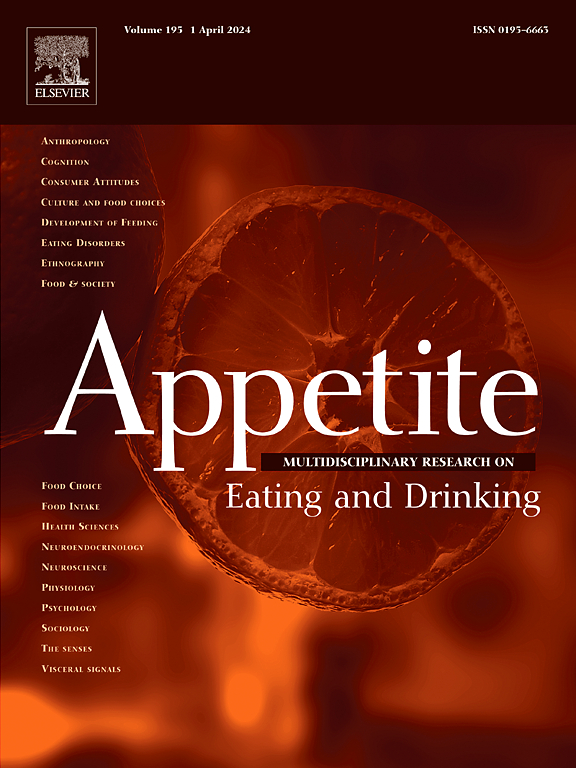Influence of infant feeding practices on childhood dietary patterns in Upstate KIDS
IF 4.6
2区 医学
Q1 BEHAVIORAL SCIENCES
引用次数: 0
Abstract
Background
Earlier feeding practices may influence dietary preference. We evaluated if age of introduction to select complementary foods shape intake and diet quality as measured by the Youth Healthy Eating Index (YHEI) in childhood.
Methods
Parents from the Upstate KIDS cohort reported complementary food introduction of 4–12-month-old infants on food questionnaires. Children with information on infant feeding and diet at 30–36 m (n = 2826) and 7–9 years of age (n = 1449) were included. Associations of age of complementary food introduction with intake in childhood were modeled with Poisson regression and diet quality score with linear models, adjusting for sociodemographic factors.
Results
Approximately 84 % (n = 2383) of mothers were non-Hispanic White and about 19 % (n = 526) of children were twins. At 30-36 months, compared to introducing fruits and vegetables between 5 and 8 months, introducing later was associated with 13 % lower daily intake of fruits and vegetables (aRR, 0.87; 95 %CI: 0.79, 0.95); while dairy and grains were associated with a 10 % and 17 % lower intake, respectively. Later introduction of protein was associated with 6 % (aRR, 0.94; 95 %CI: 0.90, 0.98) lower intake. For diet quality, introducing fruits and vegetables later (adjusted B: −4.01; 95 %CI: −7.42, −0.60) was associated with lower diet quality relative to 5–8 m. Later (adjusted B: −1.98; 95 %CI: −3.21, −0.74) introduction to dairy was associated with lower diet quality.
Conclusion
Timing of select complementary foods was associated with lower subsequent intake and lower diet quality in childhood. Further research is needed to evaluate feeding practices that may affect food preferences during infancy as a way to impact healthy dietary patterns and diet quality.
婴儿喂养方式对北部儿童饮食模式的影响。
背景:早期的喂养习惯可能会影响饮食偏好。我们通过青少年健康饮食指数(YHEI)来评估儿童开始选择辅食的年龄、形状摄入量和饮食质量。方法:来自Upstate KIDS队列的父母在食物问卷中报告了4-12个月婴儿的辅食引入情况。研究纳入了30-36岁(n=2826)和7-9岁(n=1449)具有婴儿喂养和饮食信息的儿童。在调整了社会人口因素后,采用泊松回归和饮食质量评分线性模型建立了儿童补充食品引入年龄与摄入量的关系。结果:约84% (n=2383)的母亲是非西班牙裔白人,约19% (n=526)的孩子是双胞胎。在2-3岁时,与在5-8个月间引入水果和蔬菜相比,较晚引入的儿童每日水果和蔬菜摄入量降低13% (aRR, 0.87;95%ci: 0.79, 0.95);而奶制品和谷物则分别降低了10%和17%的摄入量。后期引入蛋白质与6%相关(aRR, 0.94;95%可信区间:0.90,0.98)。在饮食质量方面,后期引入水果和蔬菜(调整B: -4.01;95%CI: -7.42, -0.60)与相对于5-8米较低的饮食质量相关。后期(调整B: -1.98;95%可信区间:-3.21,-0.74)。结论:选择辅食的时间与儿童期低摄入量和低饮食质量有关。需要进一步的研究来评估可能影响婴儿食物偏好的喂养方法,以影响健康的饮食模式和饮食质量。
本文章由计算机程序翻译,如有差异,请以英文原文为准。
求助全文
约1分钟内获得全文
求助全文
来源期刊

Appetite
医学-行为科学
CiteScore
9.10
自引率
11.10%
发文量
566
审稿时长
13.4 weeks
期刊介绍:
Appetite is an international research journal specializing in cultural, social, psychological, sensory and physiological influences on the selection and intake of foods and drinks. It covers normal and disordered eating and drinking and welcomes studies of both human and non-human animal behaviour toward food. Appetite publishes research reports, reviews and commentaries. Thematic special issues appear regularly. From time to time the journal carries abstracts from professional meetings. Submissions to Appetite are expected to be based primarily on observations directly related to the selection and intake of foods and drinks; papers that are primarily focused on topics such as nutrition or obesity will not be considered unless they specifically make a novel scientific contribution to the understanding of appetite in line with the journal's aims and scope.
 求助内容:
求助内容: 应助结果提醒方式:
应助结果提醒方式:


